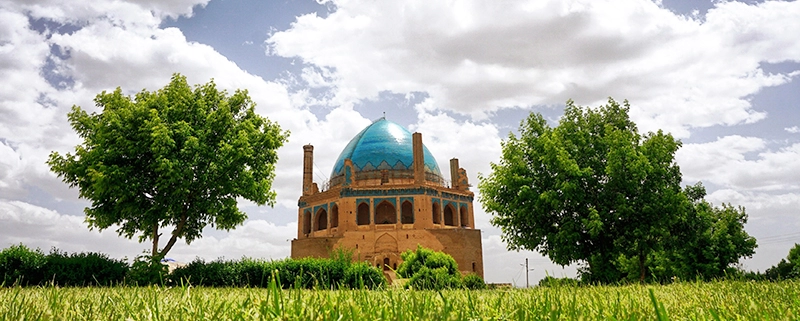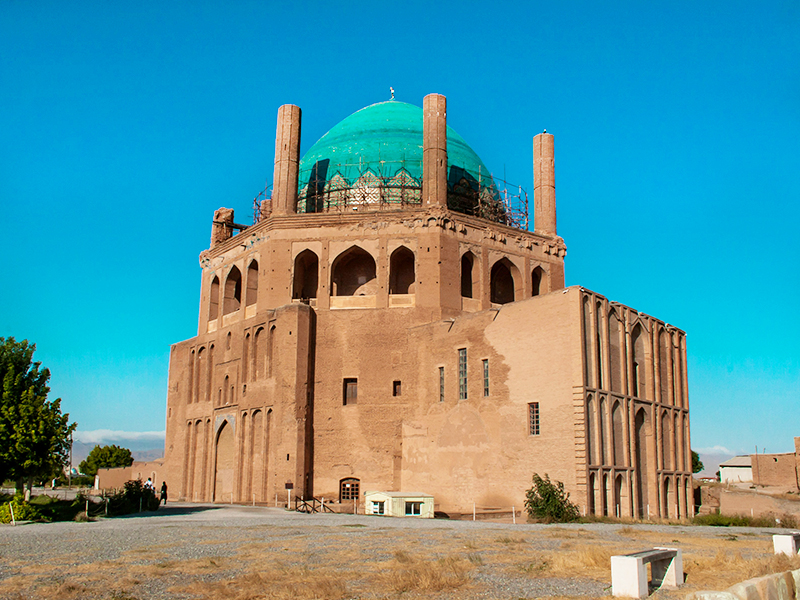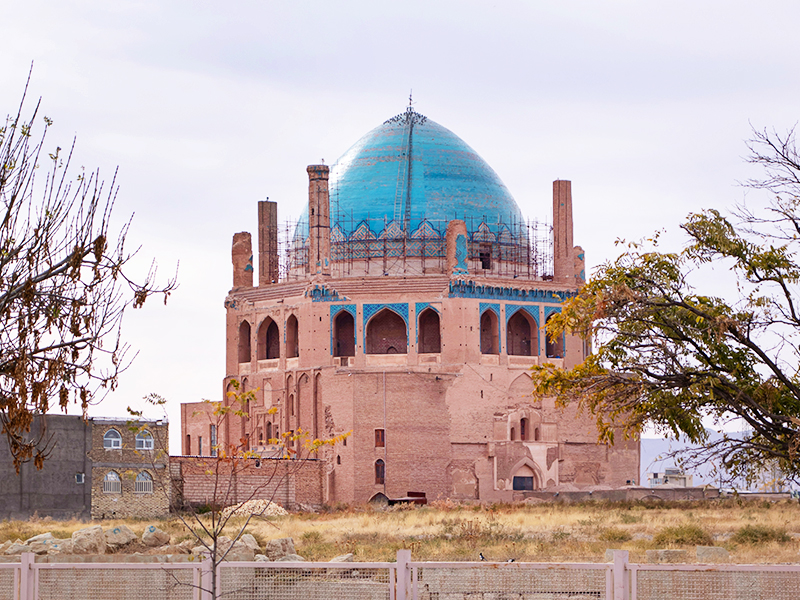Soltaniyeh Dome (History, Facts, Photos)
Iran may be a country unknown to many, but this Middle Eastern land is carpeted with countless archeological monuments bearing rich history and culture, which will bewilder any visitor. The Soltaniyeh Dome is one of Iran’s treasured ancient sites situated in the scenic Zanjan province in the northwest of Tehran. Zanjan has always been a captivating place for sightseeing antique relics of Iran with a blend of its pleasant climate and nature. You will find traditional bazaars, mosques, and several old buildings belonging to previous dynasties.
The Soltaniyeh Dome is worth seeing because it is the world’s third tallest dome after the Hagia Sophia and Santa Maria, and it also bears the title of the largest brick building in the world.
About the Soltaniyeh Dome
What is the largest dome in Iran? It certainly is the popular Dome of Soltaniyeh of Zanjan province. This brick monument is Zanjan’s most visited site in Soltaniyeh city, and if you are interested in antiquity, its colossal structure will surely grab your attention. The Soltaniyeh Dome is a precious national heritage of Iran and is marked on the list of Iran UNESCO World Heritage Sites.
Soltaniyeh Dome History
In the past, the dome of Soltaniyeh, located in Soltanieh city, was a vast plain and was used for recreation and hunting. During the rule of “Arghun Khan,” the fourth ruler of the Mongol Empire’s Ilkhanate, he ordered the construction of the Soltaniyeh city for his residence. This city was the third capital of the government after Maragheh city, situated in the East Azerbaijan province of Iran and Tabriz city during the Ilkhanid period.
Dome of Soltaniyeh was built as a tomb in the years 1302 to 1312 AD and during the reign of Sultan Mohammad-e Khodabande (known as Öljaitü), the eighth Ilkhanid ruler. This patriarchal ruler followed his father’s religion, which was shamanism. Shamanism is the name of a line of traditional beliefs in some primitive and prehistoric tribes, which still has many followers around the world today.
After the passing of some years, Oljaitu converted to Christianity following his mother and changed his name to Nicholas (Nicolo). Shortly after his conversion, Oljaitu fell ill and changed his name to “Khodabande” because there was a superstition among Oljaitu paternal tribes (Mongols).
Later, Oljaitu became a Muslim under the influence of one of his wives, Allama Hali, and his minister, Sheikh Fazlullah. After visiting the tombs of Hazrat Ali and his son Imam Hussain, he converted to the Shia Muslim religion and named himself Sultan Mohammad-e Khodabande. He built the Soltaniyeh Mausoleum (Now Dome of Soltaniyeh) to move the burial places of Hazrat Ali and Imam Hussain to this building in Soltaniyeh. However, Sultan Muhammad-e Khodabande did not succeed in doing this due to the opposition of some Shia scholars, and finally, he used the dome of Soltaniyeh as his own tomb.
Rehabilitation of the Soltaniyeh Dome
The Soltaniyeh Dome was restored and renovated by an Italian group in 1967, a project that continued until 1978. It is believed that the restoration process of this monument was one of the most delicate and complex restoration projects. Undoubtedly, the dome of Soltaniyeh ages more than 700 years, a magnificent structure with unique architecture; therefore, it required good maintenance and care.
Dome of Soltaniyeh Architecture
The Dome of Soltaniyeh is seen as one of the most intact ancient buildings in Iran, made by very skilled architects. Its intricate architecture is among the reasons for tourists to journey to this province and sightsee this magnificent structure.
What Type of Architecture Is the Soltaniyeh Dome?
The plan of the dome of Soltaniyeh is rectangular on the ground floor and first floor. The plan of the building on the second and third floors is octagonal. The style of the facade of the building is more compatible with Seljuk architecture (Seljuk Period), and there are signs of using Islamic architecture in the structure of the building, such as the installation of 110 steps in the building (synonymous with the name of Ali in Abjad alphabets).
In addition, the most important principle observed in the architecture of the building, which is the extension of the line of symmetry of the dome of Soltaniyeh, is towards the Qibla, and this also indicates Islamic elements used in the construction of the monument.
The material used in the main body of the dome of Soltaniyeh and the entire building is brick, and only in the part of the dome is a coating of turquoise and azure tiles in a mosaic style. The mortar used in the building is made with a mixture of plaster and a small amount of lime.
Interestingly, the architecture of the dome of Soltaniyeh inspired Gothic architecture. Filippo Brunelleschi, a famous Italian architect and an engineer of the fifteenth century, and Lorenzo Ghiberti, an Italian sculptor, architect, and writer, gained inspiration and used a similar style from the dome of Soltaniyeh while designing and constructing the dome of the Santa Maria del Fiore church in Italy (about 100 years after the construction of the Soltaniyeh dome).
Some researchers believe that the architecture of the Bastami Complex, which is the tomb of Mahmud Ghazan (the most powerful Ilkhanid ruler), was modeled after the construction of the dome of Soltaniyeh. The building itself is influenced by the design of the Soltan Sanjar Mausoleum (the second Seljukian ruler). Although the plans of those tombs are square, the dome of Soltaniyeh is octagonal.
Architects of the Dome of Soltaniyeh
An architect, Khwaja Rashiduddin Fazlullah Hamdani, designed the Zanjan dome of Soltaniyeh for Mohammad-e Khodabande inspired by the tomb of his brother, Mahmud Ghazan. Some people claim that the architect was Seyyed Ali Shah, while others deny it. But at least what is known is that several thousand workers were used to build this brick building until it was finally finished after six years. It took three years to decorate the building with delicate ornamentations and inscriptions.
How tall is the Soltaniyeh Dome?
The height of the building is 48.5 meters and the diameter of its inner opening is 25.5 meters. The upper part of the building is surrounded by rooms and pavilions.
Inside the Dome of Soltaniyeh (Islamic Ornamentations)
Inscriptions of the Dome of Soltaniyeh are the inscriptions of Quranic verses, which can be seen in different parts of Soltanieh Dome and on all its walls. Among these Quranic decorations, we can see Surah “Fatah” on the ground floor, Surah “Ayat al-Kursi” above the main entrance door to the mausoleum in the eastern part of the building, Surah “Ikhlas” (Tawheed) inside the porch of the first floor, verses from Surahs Al-Anbiya, Al-Momonun and Al-Mulk in the bodies.
Inscriptions with the names of Muhammad and Ali and a logo called “Ittihad,” which means Unity, are on all the walls of the first and second floors. Other inscriptions engraved with six times “Glory be to Allah,” five times the name of Prophet Muhammad, and five times the name of Hazrat Ali, Muhammad Rasulullah can be found inside the monument.
Dome of Soltaniyeh Facts
Looking at the plan of the dome of Soltaniyeh photos, you will notice the Soltaniyeh monument is octagonal. This building also had eight doors, eight porches, and eight minarets. The real reason behind using the number eight in the construction of the building is not known because this number is not considered sacred like numbers seven or twelve.
However, some researchers consider the reason for this was the possibility of creating a sundial. Others believed that the use of the number eight was for strengthening the structure. Some people also believed that the dome of Soltaniyeh was built in an octagonal form because it was inspired by the eight gates of heaven.
Sundial of the Dome of Soltaniyeh
The sundial of the dome of Soltaniyeh helped to determine the time for the religious duties of the city’s residents. In the past and now, for Muslims, knowing the time and performing religious duties and prayers is of high importance. For this reason, during the construction of the dome of Soltaniyeh, a sundial was installed in the skeleton of the building so that the residents of the city could tell the time accurately using the sunlight.
Soltaniyeh Dome sundial works in such a way that if the light shines through the hole of the main dome, it is the time of Adhan (Islamic call to prayer). The light that shines through the large windows acts as the large hour hand, and the light from the small windows indicates the minutes. At night, the stars seen from these windows helped people to tell the time.
The Mystery of the Cellar in the Dome of Soltaniyeh
There is a belief that many Mongols and patriarchal rulers were buried in the cellar with everything they had, such as gold and jewels, after their death. Due to this, it was thought that Sultan Muhammad-e Khodabande was buried there, but no grave was found there during the excavations.
Dome of Soltaniyeh Reviews
Fortunately, reviews regarding this valued ancient monument have been very positive. Receiving such wonderful feedback from all the excursionists of the world has made this spot a special location for the people of Zanjan. Some visitors mentioned the easy access to the dome and the grandeur of the location during their visit, as well as the magnetizing architecture of the Soltaniyeh Dome.
Dome of Soltaniyeh Location
The building is located in the heart of Soltaniyeh city and in the middle of Soltaniyeh citadel. To visit, you must first travel to the historical city of Zanjan and then drive from Zanjan to Qazvin. After traveling a distance of about 30 kilometers, choose the road on your right and enter Soltaniyeh Road. You will find the Dome of Soltaniyeh in the beautiful city of Soltaniyeh (Location on map).
Final Word
If you are traveling to Zanjan, one of the important attractions that awaits you on this trip is the Dome of Soltaniyeh. This dome, which is a relic of Ilkhanid period architecture, is the tomb of Oljaitu and has attracted many sightseers who are fond of ancient sites. This dome is the largest brick dome in the world and the third largest dome in the world, and what is interesting is that the architecture of this building inspired the construction of the Santa Maria Church in Italy, the Hagia Sophia in Istanbul, Turkey, and the Taj Mahal in India.
Are you planning to travel to Iran and looking for an Iran travel agency? Check out our Iran tours.










Leave a Reply
Want to join the discussion?Feel free to contribute!